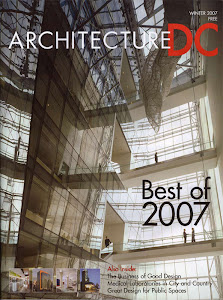
 Modern architecture has been popping up in almost all of Washington's neighborhoods lately. The revitalizing urban neighborhood of NoMa (North of Massachusetts Avenue) has become one of the hotbeds for examples of current ideologies in urban modernism. The fabric of this neighborhood contains many vacant lots which are being utilized for the incorporation of modern design into the existing historical context. Many of these new infill projects are designed by Suzane Reatig Architecture, http://www.reatig.com/ . Today's most innovative technologies and materials such as storefront glazing systems, curtain wall technologies, and raw commercial materials such as prefabricated concrete structure and concrete block sit next door to classical Washingtonian rowhouses. Both typologies are very unique and can contrast with each other. In these examples, there is a relationship in scale, massing, use, and texture. Both the historic and the modern example compliment the other, without mimicry or direct interpretation, but by letting the other stand on its on merit. Here both the old and the new have individual importance and clarity, but work together to create a cohesive and unique streetscape. A primary difference between the new and the old is the massing placement on the building site. The historic rowhouses have their building massing predominantly towards the front of the site, while the yard space is towards the rear. In the new condo building, the building massing is focused along the front and the rear of the site, leaving a large open courtyard in the center. The openness and transparency of the architecture allow for a publicity on the street fronts while the inner courtyards create a privacy for the inhabitants as well. Modern architecture as in this example, does not take away from the importance of the historic area, but increases the significance of the existing history. The modern architecture is created for today, and will one day be an important part of the city's evolving historic fabric as well.
Modern architecture has been popping up in almost all of Washington's neighborhoods lately. The revitalizing urban neighborhood of NoMa (North of Massachusetts Avenue) has become one of the hotbeds for examples of current ideologies in urban modernism. The fabric of this neighborhood contains many vacant lots which are being utilized for the incorporation of modern design into the existing historical context. Many of these new infill projects are designed by Suzane Reatig Architecture, http://www.reatig.com/ . Today's most innovative technologies and materials such as storefront glazing systems, curtain wall technologies, and raw commercial materials such as prefabricated concrete structure and concrete block sit next door to classical Washingtonian rowhouses. Both typologies are very unique and can contrast with each other. In these examples, there is a relationship in scale, massing, use, and texture. Both the historic and the modern example compliment the other, without mimicry or direct interpretation, but by letting the other stand on its on merit. Here both the old and the new have individual importance and clarity, but work together to create a cohesive and unique streetscape. A primary difference between the new and the old is the massing placement on the building site. The historic rowhouses have their building massing predominantly towards the front of the site, while the yard space is towards the rear. In the new condo building, the building massing is focused along the front and the rear of the site, leaving a large open courtyard in the center. The openness and transparency of the architecture allow for a publicity on the street fronts while the inner courtyards create a privacy for the inhabitants as well. Modern architecture as in this example, does not take away from the importance of the historic area, but increases the significance of the existing history. The modern architecture is created for today, and will one day be an important part of the city's evolving historic fabric as well. 
Sunday, September 30, 2007
Modernism In Your Neighborhood
Subscribe to:
Post Comments (Atom)









No comments:
Post a Comment